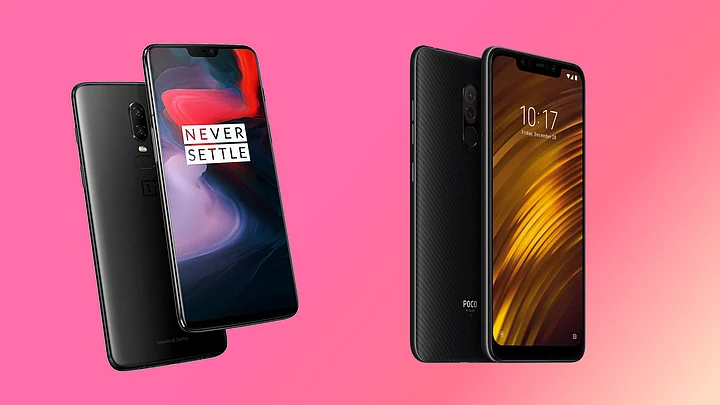OnePlus 6 launched a few months back in India and has got a good response from consumers. Even though it costs more than the OnePlus 5T, buyers have gotten used to the brand’s value proposition, opting for flagship features with a relatively affordable price.
OnePlus’ success has alerted Xiaomi, which has brought in its sub-brand Poco. Its first product, the Poco F1, pushes the limits of how much a flagship-like phone can cost in the market.
So, it was obvious that we had to bring you a spec comparison between the OnePlus 6 and the Poco F1. Both have similar features, but the price tag is the Poco’s X-factor.
Design
OnePlus 6, unlike any other OnePlus phone, gets a glass body design, a notch on the front and a 19:9 ratio screen with slim bezels.
Compared to the 16:9 ratio bearing OnePlus 5 and 18:9 ratio sporting OnePlus 5T, this one gets a big design upgrade. The size of the fingerprint scanner is smaller than before and the dual rear cameras are placed vertically as well. It looks elegant, but not before showing up its attraction for smudges and bruises in some cases.
The material design used by the Poco team is reminiscent of what we’ve seen with OnePlus devices over the years. But with Poco F1, you kind of remember the Nokia Lumia phones with premium plastic coating.
Poco is using polycarbonate materials to design the back body of the Poco F1. Unlike the glass-metal combo used by most phone makers these days, we prefer the former, for its durability more than anything else.
It’s hard to say which one is better here and clearly depends on the choice of the buyers in most cases.
Display
The OnePlus gets a 6.2-inch AMOLED screen, has 2280x1080 pixels resolution and claims to have Corning Gorilla Glass 5 for protection. OnePlus makes a better case for the notch than most companies. It’s clear in daylight and works great indoors as well.
The text spacing around the notch is neatly wrapped and even the size of the notch is comparatively smaller.
Also, the way OnePlus 6 has used the 19:9 ratio screen is better than most. Its limited bezel space ensures more display real estate for viewing.
The Poco F1 is no different with its screen, except for the size being marginally smaller than what you get with the OnePlus 6. The 6.1-inch screen sports a 2246x1080 pixels resolution, but the cost-cutting measure shows up with the use of Corning Gorilla Glass 3 instead of 5.
Hardware & Software
You can literally copy-paste the features of the OnePlus 6 and that’ll work for the Poco F1 as well. Both the phones come packing the octa-core Snapdragon 845 processor, with RAM options going up to 8GB. For storage, you can choose between 64, 128 and 256GB, but Poco F1 lets you expand it further via the hybrid SIM slot.
These are top-of-the-line features, that a few years ago you would have expected only from a Samsung, LG or Sony. But this is 2018 and consumers couldn’t have asked for more. The Snapdragon 845 has proved to be a reliable performer, erasing memories of the heating issues Qualcomm faced with its Snapdragon 810 a few years back.
Just in case you were wondering, both the phones get a 3.5-mm audio jack.
Both the phones support 4G VoLTE, while Poco F1 goes a step further and lets you run on VoLTE with both the SIM slots. Battery wise, you get 4000mAh on the Poco F1. But OnePlus even with a smaller 3300mAh battery, wins the round, purely for its dash charging support.
OnePlus 6 is running on Oxygen OS, designed by the OnePlus team, which is very close to a stock Android setup, but gets an intuitive set of features and gesture support for navigation. Poco F1 has opted to stick with MiUI, but uses a Poco Launcher with some lightweight tweaks to make the user experience nimble and friendly.
Camera
This is where we feel OnePlus 6 will have an upperhand by offering more to avid shutterbugs. The phone gets dual rear cameras of 16 and 20 megapixels with f/1.7 aperture. OnePlus ditched the telephoto lens in favour of the regular lens with better handling in low-light conditions. There’s a 16 megapixel unit on the front.
Poco F1 gets 12 and 5 megapixel sensors at the back with aperture f/1.9 on the primary lens, while the secondary one handles the depth-sensing duties. The Poco F1 gets a 20 megapixel camera on the front.
We know what the OnePlus 6 is capable of, but we are still testing the Poco F1’s cameras. Watch for another comparison of the cameras soon.
Worth It?
This is where the Indian mindset could change the dynamics. OnePlus 6 offers good value for what it features; hardware as well as software. The cameras are decent and the battery life gets a boost with the dash charging support.
For Rs 35,999 for the 64GB storage / 6GB RAM variant, OnePlus 6, till earlier this week looked like a pretty decent deal. But with the Poco F1, priced starting at Rs 20,999 for the 64GB storage / 6GB RAM variant, you’re looking at another affordable flagship device, reminiscent of Xiaomi’s Mi3 a few years ago.
Having said that, you can easily get the OnePlus 6 from online or offline stores, but good luck getting the Poco F1, which is likely to have a flash sale soon, where stocks may run out in a blink.
(At The Quint, we question everything. Play an active role in shaping our journalism by becoming a member today.)
